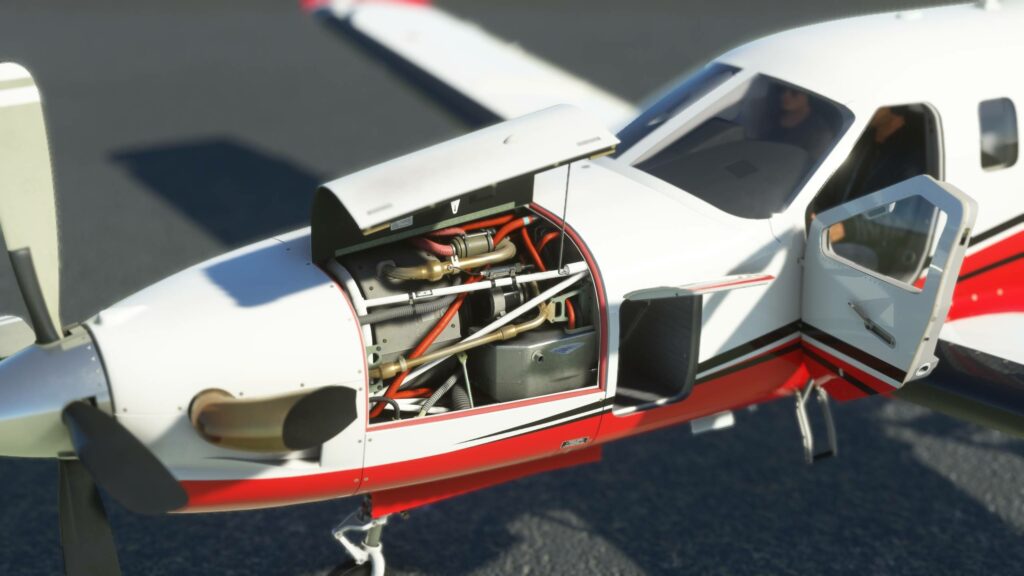
Die früheren Black Square Flugzeug sollen nach und nach die gleichen Features erhalten, wie spätere Releases – das hat Entwickler Nick Cyganski im Rahmen der FSExpo versprochen. Den Anfang macht jetzt die TBM 850, für die ein großes Update bei Just Flight bereitsteht.
Die größte, sichtbare Verbesserung sollte dabei die Integration des Tablets sein, das auch wie in den Dukes die Systeme in Echtzeit darstellt und zur Konfiguration der Maschine gedacht ist. Ergänzend wurde die Simulation des Propellers nochmal überarbeitet und auf den neuesten Black Square Stand gebracht.
Hier das Changelog im Original:
v1.2 – Major Update: Tablet, Exterior Elements & RNAV Autopilot
New Features:
- NEW TABLET INTERFACE! The same great tablet interface you’ve come to enjoy in the Black Square Duke’s added to the Black Square TBM 850 for free. Configuring options, hot-swapping avionics, payload settings, failure management, from the tablet, with real time visualizers for engines, electrical schematics, and environmental systems.
- Improved environmental system accuracy necessary for the tablet visualizer
- Exterior elements available via the tablet interface, such as pitot covers with “Remove Before Flight” flags that blow in the wind, engine covers, wheel chocks, and external power cart.
- Improved external power logic for use with the exterior elements options on the tablet.
- Wing flex added.
- The KNS80 RNAV unit is now capable of controlling the autopilot when no GPS is selected as the primary radio. See the “Using the KNS-80 RNAV Navigation System” for more information.
- Added turbine engine specific failures enabled by the improved engine simulation required for the tablet visualizer, such as compressor stall and surging, P2.5 bleed valve failures, and fuel control unit failures.
- Improved deicing visuals on the exterior model. Ice will now break off of the leading edge of the wings only where there are boots, and melt slowly from heated surfaces.
- Added SU15 ground handling parameters.
- Added functional weather radar gain, controlled by the existing gain knob.
- New sections added to the manual on the tablet interface, and control inputs and output variables, extending the manual from 109 to 160 pages. Enjoy!
- More equipment temperatures are now calculated for display on the tablet.
- Instant Beta on Touchdown option added to the tablet interface. Due to hardware deadbands, Black Square aircraft do not enter propeller beta range after touchdown if the hardware controller was already in the beta range before touchdown. Enabling this option will apply full beta after touchdown to begin slowing the aircraft without the need to “bump” your hardware throttle.
- Added true Pitch Sync functionality to yoke CWS buttons. Pressing and holding “L:var_PilotCws” or binding “K:SYNC_FLIGHT_DIRECTOR_PITCH” to hardware controls will now allow the aircraft to be maneuvered in pitch while temporarily disabling the autopilot pitch servo.
- A persistent tablet option has been added for a static tablet position more comfortable for VR users. The option, titled “VR Tablet Static Position” will affix the tablet in a location farther away from the camera, obscuring as little instrumentation as possible.
- Improved propeller governor simulation for smoother speed adjustments when testing overspeed limiter, and propeller governor failure is now gradual.
- Added a visual detent to the power lever to indicate the flight idle position, as already exists in the Turbine Duke.
- Reverse compatibility for VATSIM clients that use “COM RECIEVE ALL” for monitoring COM2 audio while transmitting on COM1.
- Added emissive light source on the overhead panel lighting posts.
- High bleed air flow torque performance reduction simulated.
- Added support for 0.5 kHz ADF frequency tuning on the KR 87. A secondary click on the power knob will increment the standby frequency by 0.5 kHz, which will indicate on the display with a small dot to the left of the frequency.
- PMS50 WTT Mode has been integrated natively, so no additional packages are required to enjoy the advanced autopilot features available with the PMS50 GTN 750 as the primary source of navigation.
- L:Var outputs have been added to all annunciator lights for use with home cockpits.
- Added support for WeatherSquare 4000.
Bug Fixes:
- Finally! There is a solution for the simulator’s internal rounding error when setting COM frequencies above ~134 MHz. These frequencies will now work properly with 3rd party air traffic control clients in all Black Square Aircraft.
- Gas generator vs. density altitude curve corrected for throttle response.
- ITT and torque curves adjusted for more correct limiting factors at altitude.
- Parasitic drag scaler increased by 1%. High altitude cruising speeds are now correct to the knot based on POH tables.
- Dynamic oxygen consumption was erroneously using the outside air pressure, rather than the interior cabin pressure to calculate the biological oxygen requirement. Oxygen consumption in a partially pressurized cabin will now be substantially reduced.
- Fixed several oversights in the electrical system pertaining to the essential bus tie.
- Fixed annunciator panel test logic so active annunciators do not illuminate when the currently tested circuit does not have power.
- Fixed GPS OBS setting with EHSI course knob when using WT GNS and PMS50 GTN.
- Engine Trend Monitor shaft horsepower and specific fuel could read slightly high when ram air pressures were low.
- RNAV distance would wind up to 999.9nm when a valid DME station was tuned, but the aircraft was on the ground. This was due to interpolation added for autopilot control.
- Performance fix for when both PMS50 GTN 750 and TDS GTNxi 750 are installed.
- The autopilot would not follow the NAV2 VOR course deviation when selected on the EFS 40 EHSI in some circumstances.
- Volume knob momentary push on the TDS GTNxi was producing “Knob Stuck” warning.
- Airframe deicing controller circuit breaker was not tripping with failure.
- Torque will no longer diminish at middle throttle settings when using time acceleration.
- Overtorque annunciator warning and ETM exceedence redline adjusted.
- Annunciator panel test switch inverted to test correct circuit.
- Elevator control sensitivity reduced at low dynamic pressures.
- VR Pilot Camera position set to match non-VR pilot viewpoint by default.
- Fixed secondary GNS 530 com volume knob incorrect animation name.
- Fixed COM 1 KX155 volume knob animation that had a lower maximum position than the COM 2 KXX155.
- Increased glareshield light emissive intensity.


von Neuen Sound Steht da nix oder hab ich es nicht gefunden, mir geht der Standard Sound auf die Ohren.
Nein, neue Sounds gibt es leider noch nicht, wurde aber im Forum vorab schon ausgeschlossen für diesen Release.
Weiß jemand, was WeatherSquare 4000 ist?
Gute Frage! Ich hab mal im Forum nachgefragt. Mal schauen, ob es jemand weiß.